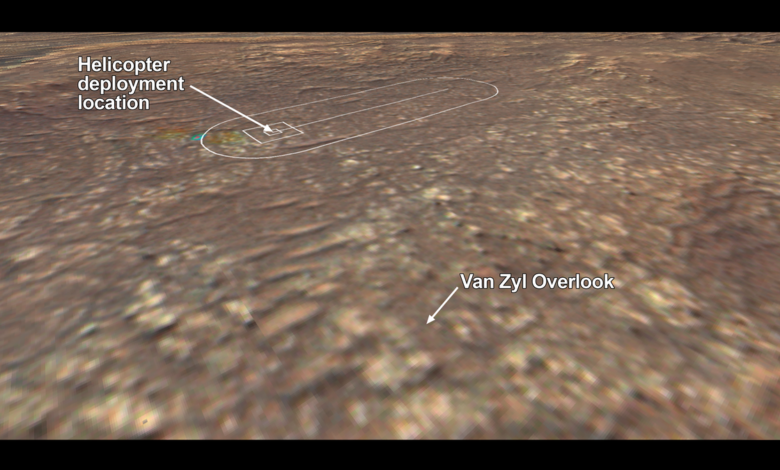
A Black science fiction author who believed she could write better stories than those in B-grade movies, and a former NASA senior director who gazed at the stars while growing up in a remote part of Africa have been honored with Mars Perseverance sites named after them.
The names of Octavia Butler, an award-winning writer, and Jakob van Zyl, a brilliant engineer and manager who helped send spacecraft across the solar system, are now part of the Perseverance rover’s mission. Their names now designate where the rover landed and where it will watch the Ingenuity helicopter fly.
"There's a tradition for Mars rover teams to name their landing sites after someone they want to commemorate," says Kathryn Stack Morgan, deputy project scientist of the Mars 2020 rover mission.

"The model we used was the Mars Science Laboratory's Curiosity rover mission, which named its site after (science fiction author) Ray Bradbury in 2012."
NASA's Jet Propulsion Laboratory designated the Perseverance rover’s landing site as the Octavia E. Butler Landing on March 5, just 13 days after touchdown on the Martian surface.
The rover will use an observation point designated as the Van Zyl Overlook to record Ingenuity helicopter tests, JPL said on March 23.
There was a light about Jakob — anyone who met him left feeling better about themselves. He was a warm, optimistic, energetic person.
Van Zyl has a strong personal connection to the Mars 2020 staff. Many of them worked alongside him on some of JPL's most notable missions.
The helicopter tests are the first powered flights on another planet. The observation area was originally called "Twitcher's Point," a reference to the British term "twitcher", used for someone who will travel a long distance to see a rare bird.
Both designations add personal touches and human faces to an ambitious, much-anticipated space mission in which unmanned vehicles are the stars.
Inspired by science fiction
In talking about Butler, people on the JPL team said "so many of us were inspired by science fiction, to become scientists, engineers and pursue space exploration," Stack Morgan says.
The designation was also "a way to reach beyond the planetary science community that, like many other STEM fields, is not very diverse." Stack Morgan says.
"By naming the Perseverance landing site in honor of Octavia E. Butler, we were hoping to make a connection between the mission and someone who has served as an inspiration and connection to science for those typically underrepresented in the planetary science community, and STEM fields more broadly."

'We couldn't have gotten there without him.'
The designations also give close-knit JPL teams a chance to pay tribute to a colleague.
Van Zyl passed away unexpectedly of a heart attack at age 63 on Aug. 24, a month after the Perseverance launch. He is survived by his wife, Kalfie, and two siblings.
He retired from the JPL in 2019 after a 33-year career that included a number of management positions. After his retirement, he co-founded Hydrosat, a startup to develop satellites to measure ground moisture for agricultural applications.
The Ingenuity helicopter was one of his last projects at the JPL.
"Engineers are kind of viewed as the dispassionate, running-the-numbers-spreadsheets kind of people, but as you've seen from these celebration videos, it's a very human experience, too."
"Jakob meant a lot to everyone at JPL, the Ingenuity team in particular," says Robert Braun, director of Planetary Science. Van Zyl was his predecessor.
"When the Perseverance and Ingenuity teams decided to name this overlook in his honor, I thought it was perfect. If he were here today, he would be looking over the team and wishing them well. There's something poetic, something that just feels right about this."

Van Zyl was "in many ways our benefactor at JPL," says Tim Canham, Mars helicopter operations lead.
"He was the one who went out and rustled up support for us. He's been highly influential over the years for a lot of these technology demonstrators. We couldn't have gotten there without him."
NASA will cite Octavia Butler and Jakob van Zyl in mission reports and scientific papers, ensuring each a place in space exploration history. It's a fitting honor because, despite their vastly different backgrounds, both were drawn to the stars.
Both traveled a long way to the peak of their professions.
Octavia Butler: Groundbreaking science fiction author
Science fiction aficionados — readers, college professors and publishers — hold Butler in high regard.
"She's important because she's a pioneer and the first Black female science fiction author," says Lisa Yaszek, Regents professor of science fiction studies in the School of Literature, Media and Communication at Georgia Tech.
Butler rose to prominence in the traditionally white bastion of science fiction. She was the first to write about prominent Black characters in science fiction settings, using dystopias, time travel and other tropes.
"She was literally one of the first, if not the first, Black women to publish in modern science fiction magazines under her own name," Yaszek says.
She was also the first Black woman to win both the Hugo and Nebula awards, which are the top awards in science fiction. That's like getting the Oscar and the Golden Globe.
"She was also the first Black woman to win both the Hugo and Nebula awards, which are the top awards in science fiction," Yaszek says. "That's like getting the Oscar and the Golden Globe."
Her most impressive recognition came in 1995, when she became the first science fiction author to receive a $295,000 award as a prestigious MacArthur Foundation Fellow, often called a Genius Grant.
In 2000, she was given the PEN American Center Lifetime Achievement Award in Writing.

None of that came easy.
Born in 1947, Butler grew up in Pasadena, California, not far from the California Institute of Technology, which manages the JPL for NASA. "(Butler's selection) was a kind of local tie-in to JPL and the mission," Stack Morgan says.
Butler's father died when she was 7, and she was raised as an only child by her single mother and maternal grandmother.
It was a difficult life of poverty.
"Her mother was a maid; she would bring home books her employers threw away," says Shelley Streeby, author of "Imagining the Future of Climate Change" and professor of Ethnic Studies and Literature at the University of California San Diego.
"Octavia would create piles of them in her room and read them later. She would go to the Pasadena Public Library and the downtown public library. They were like second homes to her."
Butler was shy in school and struggled with dyslexia. She was bullied because she had difficulty with schoolwork and because of her height — she was reportedly 6 feet tall at 15. Despite her dyslexia, she read everything she could and found comfort in reading and writing.
Mars was indirectly the reason Butler decided to write science fiction.

She was widely quoted as saying she decided to become a science fiction writer at age 9 after seeing the 1954 movie "Devil Girl From Mars," a low-budget film awful enough to be a candidate for Mystery Science Theater 3000 or RiffTrax ridicule.
Everyone's heard that story but, "It encouraged her to try her own hand at writing science fiction and imbue it with more ambitious ideas and themes, connected to Black history and the future of our planet," Streeby says.
Butler's books have surged in popularity in the wake of climate change and political partisanship.
"She emphasizes survival, how we will create possibilities in the wake of disaster," Streeby says.

On Sept. 3, 14 years after her death, Butler made her first appearance on the New York Times best-seller list. "Parable of the Sower" was listed at No. 14, fulfilling a declaration Butler wrote in a notebook in 1988.
"If you've never read Octavia Butler before, or even if you've never read science fiction in particular, she's a wonderful writer to explore," says Sheree Renée Thomas, editor of the "Magazine of Fantasy & Science Fiction."
"She's a master storyteller. She wrote from the inside of the characters out, in terms of really wonderful character development. These are people you can root for, which is important, especially when she places them in extraordinary, challenging circumstances."
"Geez, I can write a better story than that!"
Beyond that, "she was one of the first people to put the experiences of Black women at the center of science fiction," Streeby says. Before that, "they were rarely protagonists in science fiction stories and novels."
Butler returned to Mars throughout her career.
"Most of her stories were set on Earth, but in both the final books of her Lilith's Brood and Parable series, Mars becomes the destination for humans who find they need something more or different than the futures here on Earth," Yaszek says.
Butler left an impression on those she encountered. She was mentored early in her career by speculative fiction authors Harlan Ellison and Samuel R. Delany. In turn, she made sure to mentor up-and-coming writers herself.
"She was a great person," Thomas says. "When you first met her, you were a little nervous, because she's very tall and stately, her personage is very elegant and beautiful, with a distinctive voice.
"I would encourage you to listen to her interviews, to hear her voice. (She had) a great sense of humor and was very insightful."

Octavia Butler died Feb. 24, 2006, at age 58, after a fall at home. She was inducted into the Science Fiction Hall of Fame in 2010.
Her name can be found beyond Mars.
A mountain on Charon, one of Pluto's moons, was named Butler Mons (mons means "mountain") after being discovered by the New Horizons space probe in 2015.
And 7052 Octaviabutler is an asteroid in solar orbit between Mars and Jupiter that was given her name after its discovery in 1988.
Jakob van Zyl: Team member in the trenches
Jakob van Zyl was born in Outjo, in Namibia, Africa, in 1957. That's about 140 miles from the Spitzkoppe Mountains, where the "Dawn of Man" scenes were shot for the 1968 film "2001: A Space Odyssey."
In a 2013 INKtalk, he told the audience that growing up in a remote area triggered his interest in space exploration.
My journey started in Namibia, where I was born. I would spend many nights as a child outside, and I would always be fascinated by the Milky Way painted across that beautiful dark African sky.
"The thought that always came in my mind was one of wonder. What is out there? It is possible that on one of those specks of light somebody is looking at me?"
After earning a degree in electronics engineering in 1979 from the University of Stellenbosch, South Africa, van Zyl came to the United States and enrolled at Caltech in 1982. He earned a master's degree and a doctorate in electrical engineering.
He joined JPL in 1986 and stayed for 33 years in various positions, including director for Astronomy, Physics and Space Technology. He was director of Solar System Exploration and was also the associate director of Project Formulation and Strategy, aimed at mapping out JPL's future.

"There was a light about Jakob — anyone who met him left feeling better about themselves. He was a warm, optimistic, energetic person," Braun says.
"He was a brilliant guy and a really good person, just really, really nice to be around," says Håvard Grip, Ingenuity chief pilot. "Super easy-going, non-pretentious. We owe a tremendous amount to him for getting to where we are with this project."
Van Zyl was part of high-profile missions that sent unmanned spacecraft to distant planets, including the Cassini craft to Saturn in 1997; Dawn to the asteroid belt in 2007;Juno to Jupiter in 2016; and the InSight Mars lander and MarCO CubeSats in 2018.
"We dare mighty things and we do things that haven't been done before," Braun says. "(The JPL) is full of engineers and scientists who spend all their time focused on the risk, the challenge and the possibility of failure.
"To have someone like Jakob, with that warmth and optimism leading the team, tends to be pretty important at a place like JPL."

"It's very sad time for the team. (Van Zyl) wanted to be there with us to watch that first flight," Canham says. "That's why the team advocated to name that place for him."
"Engineers are kind of viewed as the dispassionate, running-the-numbers-spreadsheets, kind of people, but as you've seen from these celebration videos, it's a very human experience, too.
"A lot of us on the helicopter project have been in the trenches for the better part of five years. We're very close, and Dr. van Zyl was right there alongside of us. So it's really a tribute to a member of the family in many ways."
"A lot of us on the helicopter project have been in the trenches for the better part of five years. We're very close, and Dr. van Zyl was right there alongside of us."
Van Zyl also impressed colleagues as a teacher.
"I didn't know him personally, though I did take a course with him at Caltech," Stack Morgan says. "He was fantastic. He was an engaging lecturer and had a way of making remote sensing and radar science fun and entertaining. Probably not many people can do that."
NASA said van Zyl received world recognition for his research in imaging radar polarimetry, the science of polarization information contained in radar waves.

He received a number of honors throughout his career, including the Fred Nathanson Memorial Radar Award in 1997 for advancement of radar polarimetry, radar interferometry, and synthetic aperture radar from the Aerospace and Electronics Society of the IEEE.
In 2010 he received the Distinguished Achievement Award from the Geoscience and Remote Sensing Society of the IEEE for his contributions to polarimetric SAR remote sensing, NASA said.
Van Zyl was passionate about encouraging young people in Namibia and South Africa to pursue science, the JPL said.
The University of Stellenbosch honored him in 2015 for his work on space missions, for working as an ambassador for Africa, and for inspiring students in Namibia to study science and engineering.
CONTRIBUTING Emily Johnson, USA TODAY
TOP PHOTOS: Octavia Butler, Ching-Ming Cheung; Jakob van Zyl, NASA/JPL-Caltech; others by NASA/JPL
SOURCE USA TODAY reporting and research; NASA/JPL; octaviabutler.com; eas.caltech.edu; International Astronomical Union; Associated Press
Source link








